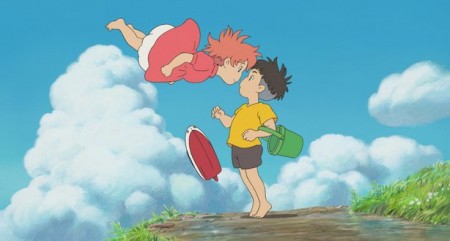Ask John: Why is Ponyo Getting Mixed Reviews in America?

Question:
Why are reviews towards Ponyo more “mixed” than for that of Spirited Away? While the Rotten Tomatoes score for Miyazaki’s latest is strong, the critics don’t sound entirely enthusiastic, and the fans on boards seem very jaded about the film. Personally, I thought Spirited Away was more derivative than his usual work, even thought it was deliberately trying to a show a different take than what’s currently popular in Japan. Yet Ponyo seems to be criticized for its “lack of plot,” particularly from Oshii after Sky Crawlers, ironically enough. But what exactly happens in Spirited Away, except for Chihiro running around a creepy fun-house for a couple hours? Why does every film have to have some sort of epic battle or drama in the foreground to get people’s attention?
Answer:
I believe there’s a rather simple explanation. The Studio Ghibli animated and Miyazaki directed features that have received major mainstream American theatrical release have been Princess Mononoke, Howl’s Moving Castle, and the Oscar winning Spirited Away – all three of them films with rather heavy thematic emphasis. While I don’t think that there’s a formally recognized definitive term distinguishing the tone of Miyazaki’s feature films, there’s no doubt a clearly recognizable polarity between Miyazaki’s rather lighthearted movies (Castle Cagliostro, Totoro, Kiki, Porco Rosso, Ponyo) and his more dramatic and serious films (Nausicaa, Laputa, Mononoke, Spirited Away, Howl). Fans who are explicitly familiar with Miyazaki’s work, and fans like me that have been watching Miyazaki’s new releases since the 1980s interpret Ponyo as a return to the gentler, more subtle, and more whimsical atmosphere that characterized late 80’s era films My Neighbor Totoro, Kiki’s Delivery Service, and Porco Rosso. However, Ponyo is the first playful anime feature Miyazaki’s created in over ten years, and the first film with this approach to hit American theaters. In other words, an entire generation of American anime fans and Miyazaki movie viewers have only experienced new Miyazaki films in the maestro’s “message movie” vein. Despite possibly knowing that Miyazaki has made lighthearted, whimsical films before, contemporary American anime fans may be unable to subconsciously reconcile their prior experience with Miyazaki’s serious mode and their expectation that Miyazaki movies are family films that seem mature by American standards, and Ponyo, which doesn’t adhere to these expectations.
Simple and elusive anime aren’t uncommon in Japan. Otaku oriented anime series like Aria and Hidamari Sketch have proven especially popular despite having no threatening conflicts and no moral or political proclivity. Likewise, My Neighbor Totoro in particular is a beloved Miyazaki movie in which basically nothing happens. But particularly in the case of 2D feature films, contemporary Americans expect and even demand some degree of justification. Whether it’s boisterous comedy in Aladdin or Spongebob Squarepants, romantic conflict in Beauty & the Beast; environmental awareness in Ferngully and The Secret of NIMH, ethnic respect in Brother Bear and Spirit: Stallion of the Cimarron, or action/adventure in Powerpuff Girls and Renaissance, 2D animated feature films that hit American theaters seemingly need to have some sort of justification for their existance. America doesn’t have a tradition of 2D animated feature films that trade in simple visual artistry and simple charming character interaction. The mixed reaction to Ponyo seems to bear out the fact that American critics and moviegoers just aren’t quite sure how to respond to a 2D animation film that doesn’t make any effort to justify its existence. American critics respect and praise Ponyo’s artistic excellence, but can’t resist asking, “Is that it?”
This reaction may be rooted in American expectations for 2D animation. Traditionally American society has de facto isolated 2D animation to the purpose of children’s entertainment & esoteric art house fare. While Ponyo is a children’s film, it’s a film for Japanese children – not American children. Americans expect that children’s entertainment be active and engaging enough to overcome an American child’s presumably short attention span. Ponyo flies in the face of that expectation by being a children’s film that doesn’t have frenetic action or comedy – a film that doesn’t condescend to keep children viewers occupied. At the same time, Ponyo doesn’t include the serious drama and narrative conflict that would ostensibly appeal to adult American viewers. It’s easy for Americans to temporarily set aside their instinctive distaste for 2D animation in order to praise Princess Mononoke, Spirited Away, and even Howl’s Moving Castle because these are children’s films with adult sensibilities. But Americans can’t do that with Ponyo because Ponyo is a children’s film that doesn’t conform to the conventions of American 2D children’s animation. So American viewers and critics have to acknowledge its undeniable artistic brilliance while their subconscious confusion over the film’s distinct difference from American convention arises in simultaneous criticism that the movie lacks substance, plot, or weight.
Add a Comment
You must be logged in to post a comment.


“late 90’s films”
You mean late 80s, early 90s.
I dug the answer, btw.
That was a typo. It’s fixed now.
For me at least, the problem wasn’t the lack of plot or overall conflict (I loved Kiki’s Delivery Service), it was the fact the conflict seemed to arise where there wasn’t one before. I was excited to see where the story would go at first, and the overall conclusion seemed to have nothing to do with the problem. Maybe it was the English script that did it in, but there seemed to be about five minutes of very important exposition missing from the film.
Here was my take on it for what it was worth: http://pockybox.com/pockyblog/pockyblog20090817.html